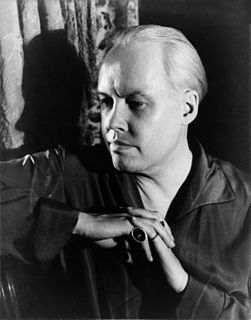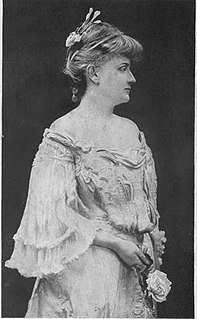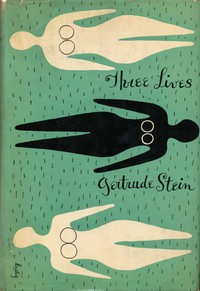
Thornton Niven Wilder was an American playwright and novelist. He won three Pulitzer Prizes — for the novel The Bridge of San Luis Rey and for the plays Our Town and The Skin of Our Teeth — and a U.S. National Book Award for the novel The Eighth Day.

Gertrude Stein was an American novelist, poet, playwright, and art collector. Born in Pittsburgh, Pennsylvania, in the Allegheny West neighborhood and raised in Oakland, California, Stein moved to Paris in 1903, and made France her home for the remainder of her life. She hosted a Paris salon, where the leading figures of modernism in literature and art, such as Pablo Picasso, Ernest Hemingway, F. Scott Fitzgerald, Sinclair Lewis, Ezra Pound, Sherwood Anderson and Henri Matisse, would meet.

Virgil Thomson was an American composer and critic. He was instrumental in the development of the "American Sound" in classical music. He has been described as a modernist, a neoromantic, a neoclassicist, and a composer of "an Olympian blend of humanity and detachment" whose "expressive voice was always carefully muted" until his late opera Lord Byron which, in contrast to all his previous work, exhibited an emotional content that rises to "moments of real passion".

Carl Van Vechten was an American writer and artistic photographer who was a patron of the Harlem Renaissance and the literary executor of Gertrude Stein. He gained fame as a writer, and notoriety as well, for his 1926 novel Nigger Heaven. In his later years, he took up photography and took many portraits of notable people. Although he was married to women for most of his adult life, Van Vechten engaged in numerous homosexual affairs over his lifetime.

James Laughlin was an American poet and literary book publisher who founded New Directions Publishing.

Julia Alvarez is an American New Formalist poet, novelist, and essayist. She rose to prominence with the novels How the García Girls Lost Their Accents (1991), In the Time of the Butterflies (1994), and Yo! (1997). Her publications as a poet include Homecoming (1984) and The Woman I Kept to Myself (2004), and as an essayist the autobiographical compilation Something to Declare (1998). Many literary critics regard her to be one of the most significant Latina writers and she has achieved critical and commercial success on an international scale.

Gertrude Franklin Horn Atherton was an American author. Many of her novels are set in her home state of California. Her bestseller Black Oxen (1923) was made into a silent movie of the same name. In addition to novels, she wrote short stories, essays, and articles for magazines and newspapers on such issues as feminism, politics, and war.
Felipe Alfau was a Spanish-born American novelist and poet. Most of his works were written in English.
Dalkey Archive Press is an American publisher of fiction, poetry, and literary criticism specializing in the publication or republication of lesser-known, often avant-garde works. The company has offices in Funks Grove, Illinois, in Dublin, and in London. The publisher is named for the novel The Dalkey Archive, by the Irish author Flann O'Brien.

Margaret Caroline Anderson was the American founder, editor and publisher of the art and literary magazine The Little Review, which published a collection of modern American, English and Irish writers between 1914 and 1929. The periodical is most noted for introducing many prominent American and British writers of the 20th century, such as Ezra Pound and T. S. Eliot, in the United States and publishing the first thirteen chapters of James Joyce's then-unpublished novel Ulysses.
Charles Henri Ford was an American poet, novelist, diarist, filmmaker, photographer, and collage artist. He published more than a dozen collections of poetry, exhibited his artwork in Europe and the United States, edited the Surrealist magazine View (1940–1947) in New York City, and directed an experimental film. He was the partner of the artist Pavel Tchelitchew.
Literary modernism, or modernist literature, originated in the late 19th and early 20th centuries, mainly in Europe and North America, and is characterized by a self-conscious break with traditional ways of writing, in both poetry and prose fiction writing. Modernism experimented with literary form and expression, as exemplified by Ezra Pound's maxim to "Make it new." This literary movement was driven by a conscious desire to overturn traditional modes of representation and express the new sensibilities of their time. The horrors of the First World War saw the prevailing assumptions about society reassessed, and much modernist writing engages with the technological advances and societal changes of modernity moving into the 20th century.

Three Lives (1909) is a work of fiction written in 1905 and 1906 by American writer Gertrude Stein. The book is separated into three stories, "The Good Anna," "Melanctha," and "The Gentle Lena."

Margery Bodine Latimer, born in Portage, Wisconsin, was an American writer, feminist theorist, and social activist. She moved to New York City before finishing college and became involved in its cultural life. Latimer published two highly acclaimed novels, We Are Incredible (1928) and This is My Body (1930), and two collections of short stories, Nellie Bloom and Other Stories (1929), and Guardian Angel and Other Stories (1932).
Mary Monroe is a New York Times bestselling African-American fiction author. Her first novel, The Upper Room, was published by St. Martin's Press in 1985. She is best known for her novel God Don't Like Ugly, and the series revolving around the characters first introduced in this book.

So Red the Rose is a 1935 American drama film directed by King Vidor and starring Margaret Sullavan, Walter Connolly, and Randolph Scott. The Civil War-era romance is based on the 1934 novel of the same name by Stark Young.
Steven Moore is an American author and literary critic. Best known as an authority on the novels of William Gaddis, he is also the author of the two-volume study The Novel: An Alternative History.

Ida A Novel is a novel by Gertrude Stein, first published in 1941.

Ryder (1928) is the first novel by Djuna Barnes. A composite of different literary styles, from lyrical poetry to sentimental fiction, it is an example of a modernist novel in the Rabelaisian tradition of bawdy and parodic fiction. Nearly every chapter is written in a different style. The novel is thought to draw on elements of Barnes's own life.
Writers within Paris in the 1920s refer to the American expatriate writers in Paris in the 1920s, They created literary works and movements that influence the global literary landscape to date. During the 1920s, political, economic and social issues shaped the inspiration behind many of the writers in Paris. The American writers in Paris in the 1920s are referred to as The Lost Generation.













